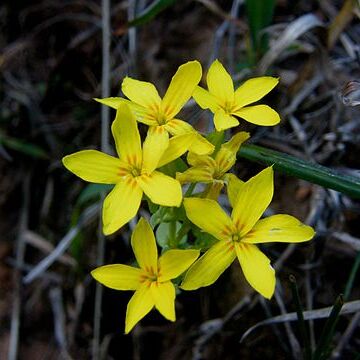Annual, glabrous herbs with fibrous roots. Flowers 4-or 5-merous. Calyx tube much shorter than lobes; lobes lanceolate or oblong. Corolla urceolate-rotate; tube ±ovoid; lobes spreading; plicae absent. Stamens equal; filaments basally adnate to corolla tube; anthers basifixed, scarcely twisted after anthesis, dehiscence longitudinal. Nectaries absent. Ovary narrowly ovoid, tapered at apex, 2-locular, with numerous ovules; style filiform, caducous; stigmas 2, linear, papillose; gynophore absent. Capsule narrowly ovoid, included in persistent perianth, dehiscent at apex. Seeds numerous, angular, striate; striae laterally finely striolate.
Fls 4-5-merous, in terminal dichotomous cymes; calyx-lobes sts keeled or winged, corolla-tube cylindric, lobes yellow, contorted in bud. Stamens at throat or on tube of corolla, filaments short; anthers introrse. Ovary 2-loculed, placentae large; style filiform, stigma clavate or capitate. Capsule ± globose, septicidally 2-valved. Seeds ∞, minute, testa reticulate. Erect glab. annual herbs of wide distribution in Old World, with opp. sessile lvs. Some 100 spp., the N.Z. sp. also in Australia, Tasmania.
Annuals. Leaves opposite; leaf blade scalelike to lanceolate. Cymes terminal. Flowers 5merous. Calyx lobed nearly to base. Corolla lobes shorter than tube. Stamens inserted at throat of corolla tube just below sinus between corolla lobes; anthers dehiscing longitudinally. Ovary 2locular. Capsules 2valved, many seeded. Seed coat alveolate.
Ovary ovoid, obovoid or almost globose, bilocular; ovules numerous; style filiform, long or short, exserted or included, sometimes with middle or basal swelling; stigma capitate, clavate more or less bilobed.
Stamens 4–5(6); filaments filiform inserted at the sinuses of the corolla or in the tube; anthers oblong, exserted or included, without or with 1 apical gland, without or with 1–2 basal glands.
Calyx 4–5-lobed, almost free or forming a short tube; lobes lanceolate to ovate or obovate, keeled or winged, papillose or scabrid on the keels.
Stems simple or branched, terete to somewhat tetragonous, usually more or less 4-ridged or winged.
Capsule ovoid or obovoid, membranous or coriaceous, septicidally bivalved.
Annual or perennial (rarely parasitic) erect, procumbent or dwarf herbs.
Leaves well-developed or reduced and scale-like, petiolate or sessile.
Corolla tube cylindric or funnel-shaped, with 4–5(6) lobes.
Seeds minute, very numerous, cubical, ridged or frilled.
Flowers 4–5-merous, terminal, solitary or in cymes.

